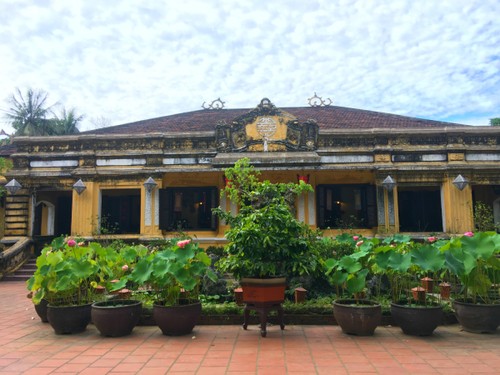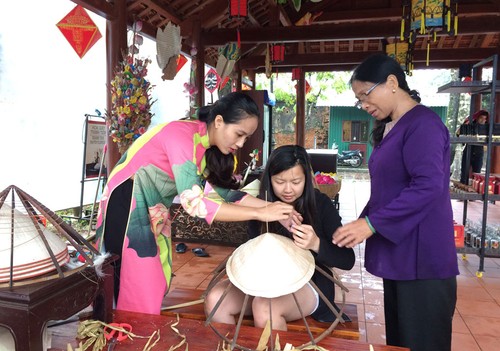 The Luc Bo Culture Space in the Hue Monuments Complex (photo: VOV) The Luc Bo Culture Space in the Hue Monuments Complex (photo: VOV) |
In addition to items of the six ministries of the Nguyen dynasty, the exhibition introduces the products of several craft villages, including kites, lanterns, ao dai, mirror paintings, and Trúc Chỉ items made from bamboo and paper. At the exhibition
The craft of making conical hats appeared in Hue about 300 years ago. Hue’s conical hats look light and elegant but are strong and durable because of their bamboo frame and dried leaves which are carefully stitched together.
Selecting the leaves, flattening and drying them, shaping bamboo strips to make the frame, and attaching the dried leaves to the frame requires a lot of effort and dedication on the part of the artisan. To make a poem conical hat, the artisan inserts a poem or image between the sheer layers of leaves.
 A visitor try to make a conical hat. (photo: hanoimoi.com.vn) A visitor try to make a conical hat. (photo: hanoimoi.com.vn) |
Nhu Quynh, a tour guide, said: “The craftsmen demonstrating their craft in the central space are making conical hats, painting on the hats, and making paper kites and flowers. Thanh Tuyen paper flower village is busiest in the 12th lunar month making flowers for Lunar New Year. They make paper lotuses in many colors. They must dye the papers, dry them in the sun, and cut them to make lotus petals. Each lotus has 9 petals.”
In another area, artisans are demonstrating royal tea and liquor ceremonies. Visitors can sample the different types of royal tea.
“There are many kinds of royal tea, scented with jasmine, licorice, goji berry, and longan. We drink it to help us relax, sleep well, and purify our body,” said an artisan.
Visitors can taste 4 types of tea – lotus tea, Thu O tea, Moc flower tea, and herbal tea. Moc flower tea and lotus tea only have one season each year. These teas are very rare. Regions that grew a fragrant tea would offer it to the King. Moc flowers only grow in the northern mountain.
The Luc Bo or six ministries cultural space is part of the Hue Monuments Complex. The building belonged to the six ministries that governed the country during the Nguyen Dynasty from 884 to 1945. They were the Ministry in charge of foreign affairs and royal ceremonies (Bo Le), the Ministry in charge of promotions, appointments, recruitment, legal affairs, training, and mandarins (Bo Lai), the Ministry in charge of marriage and family, real and personal estates (Bo Ho), the Ministry in charge of irrigation, mausoleums, monuments, and other public works (Bo Cong), the Ministry in charge of adjudication (Bo Hinh), and the Ministry in charge of military affairs (Bo Binh). The six ministries played an important role in the Nguyen feudal regime.
During the reign of King Tu Duc, a number of buildings were built in this area where crown princes would study before they ascended to the throne.
The Education Hall was built in 1881. When the Nguyen Dynasty, the last feudal regime in Vietnam, ended in 1945, Education Hall was abandoned.
In 2005 the area was handed over to the Hue Monuments Conservation Center. In 2015 the Center for Hue Monuments Service Development was assigned to repair and refurbish the buildings, yards, and surrounding facilities to host cultural events.